There are many species of fruit trees that make for incredibly beautiful, intriguing bonsai trees. From the common apple tree to the dwarf pomegranate tree, the beautiful fruits add color and life to the growing space of these miniature trees and shrubs, while producing fruits that are edible and delicious.
One of the most fascinating and beautiful species is this dwarf pomegranate, which we’ll look at today, with the varieties, care guides, classification, description, and some fun facts in mind.
Let’s take a look and see if the dwarf pomegranate bonsai is a good choice for you.
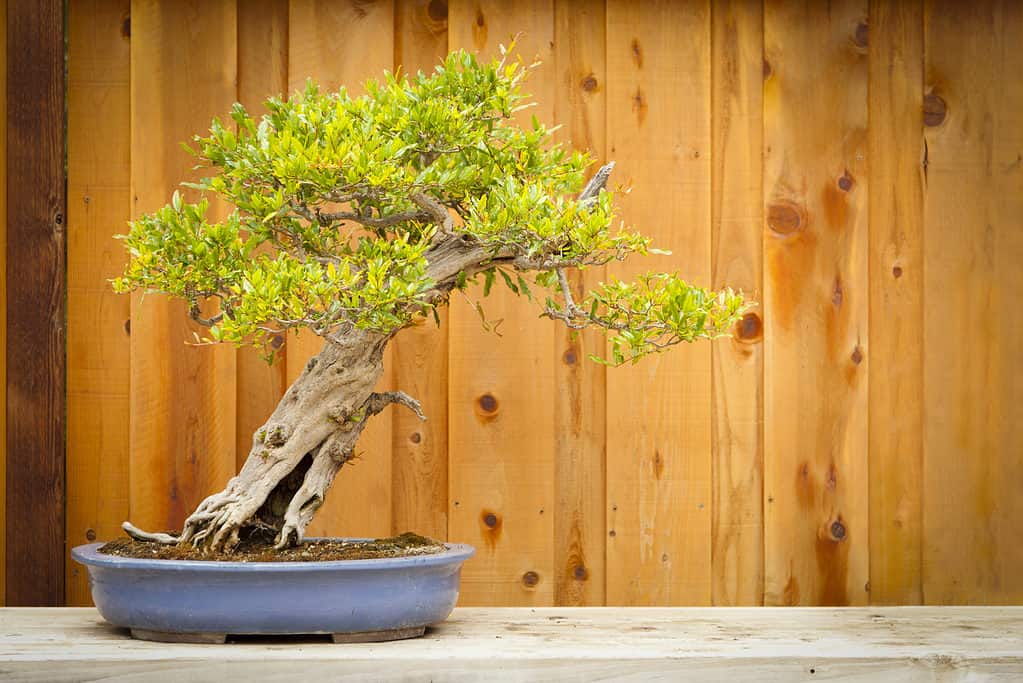
The unique fruit tree is beautiful in all seasons, both with fruit and without.
©Andy Dean Photography/Shutterstock.com
What Makes Dwarf Pomegranate Good for Bonsai?
Dwarf pomegranate trees make excellent bonsai for many reasons. First off, they are aesthetically pleasing, which is always a strong point-getter for bonsai the art form. The bright fruits and beautiful foliage win the day, as do their vibrant flowers and aromatic nature. They also have thick trunks, which make them intriguing and desirable for bonsai growing.
They produce fruit, as well, which makes them a “functional” bonsai, as well, though admittedly you won’t grow enough fruit on a single dwarf pomegranate to feed a family.
Dwarf Pomegranate Classification
The dwarf pomegranate is known as a the Punica granatum in scientific terms. The plant belongs to the Tracheophytes clade, in the Myrtales order, as a part of the Lythraceae family. Basically, they are the “miniature” version of the pomegranate tree, producing similar flowers and fruits as the full-size tree.
Dwarf Pomegranate Description
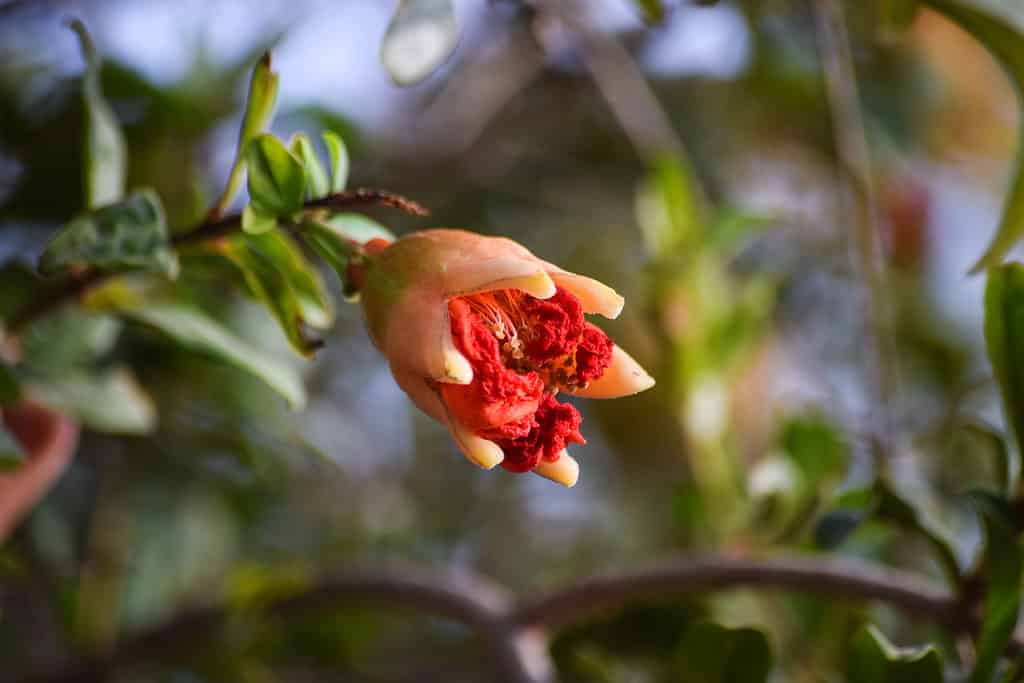
The showy and intriguing dwarf pomegranate flower truly is something to behold.
©shakeel Baloch/Shutterstock.com
The dwarf pomegranate bonsai is actually one of the most popular bonsai species around, even if it isn’t the first one you think of (most who are unfamiliar with the art form are more likely to have been exposed to fir, spruce, and pine, and even redwood or cedar trees and may think these are the only bonsai species options).
The tree has vibrant leaves in varying shades of green, and has dense, ostentatious flowering displays in orange to red blooms early on, with vibrant red or orange fruits (pomegranates). The miniature fruit looks like the full-size pomegranates, only much smaller.
Origins and History of Dwarf Pomegranate
The plant is native to ancient Persia, often found in the ancient writings and mythologies of the Old Testament Hebrews, ancient Egyptians, Persians, and many others, as well as Homeric Hymns. In the Old Testament, it most notably found in the Song of Solomon and the Book of Exodus. The tree was (and is) valued for its fruit and aesthetic appeal.
The name of the species, Punica, is from the Phoenicians who particularly cultivated pomegranates for religious purposes. Interesting the ancient city of Granada, in Spain, was renamed for the fruit during the Moorish period of the nation.
The tree made its way to the east in Japan and China via the Silk Road as trade between the Mediterranean and eastern Asia opened and it is believed to be the first internationally traded plant in the world for both ornamental and fruiting purposes.
Now, the tree is extremely popular the world over in the bonsai trade.
How to Grow Dwarf Pomegranate Bonsai
As with all plants, there are specific care instructions to keep in mind for dwarf pomegranate bonsai trees. Consider these details carefully before growing your own.
Soil Needs
Pomegranates, both full-size and dwarf, come from lands where alluvial soil is abundant. That is, they naturally grow in deposits of clay, silt, sand, and gravel within the fertile soil, typically found in a delta or river valley. This means they need precise potting mixes that will ensure their health and thriving growth for years to come. The potting mix needs to be well-draining and needs to have decomposed granite (which sounds insane, but it’s a thing!). They also need compose in the mix. A recommended mix is 60% aggregate and 40% organic.
Planting Location
In case you couldn’t guess from the original native locations of the trees, you need to keep your pomegranate bonsai in warm, airy places with plenty of light. They need drier air than high humidity, and need protection from intense sun, else the flowers and fruits will shrivel up.
Because of their native origins, they may be cultivated outdoors in similar climates but should be kept indoors in cooler climates and in wintertime if temperatures reach below about 45 degrees F.
Lighting
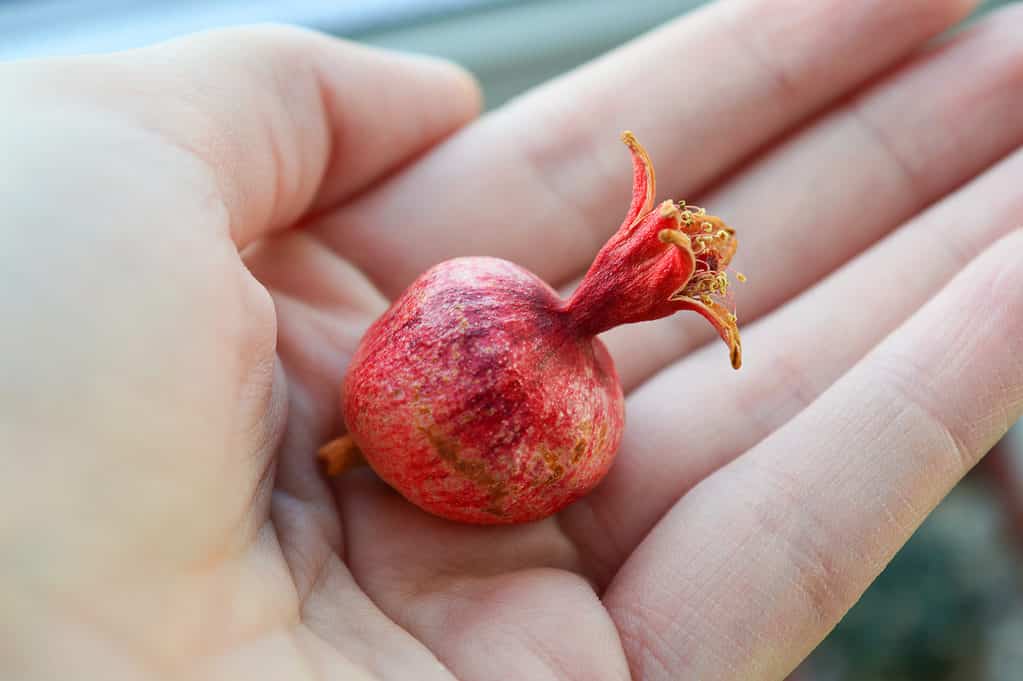
The dwarf pomegranate looks similar to full-size fruit.
©Alina Kuptsova/Shutterstock.com
For a thriving dwarf pomegranate bonsai, you’ll need to keep your plant in high, direct sunlight as much of the year as possible. They naturally live in hot, sunny climates, so they’re thirsty for sunshine year-round. They do, however, need shading in hotter parts of the year, when the sun beats down directly on the plant.
If you keep your dwarf pomegranate bonsai indoors year-round, make sure the tree is a sunny window and has grow lights available year-round to keep it healthy and happy.
Temperature
The natural climate for pomegranate trees is hot and arid. This means your dwarf pomegranate bonsai needs to be kept in areas below 41 degrees F consistently, and shaded in temperatures higher than about 85 degrees F. They may technically survive if they hit frost once or twice, but it’s highly recommended you avoid the situation.
If your outdoor space gets below 41 F, you’ll need to bring the plant indoors to keep it healthy.
Watering
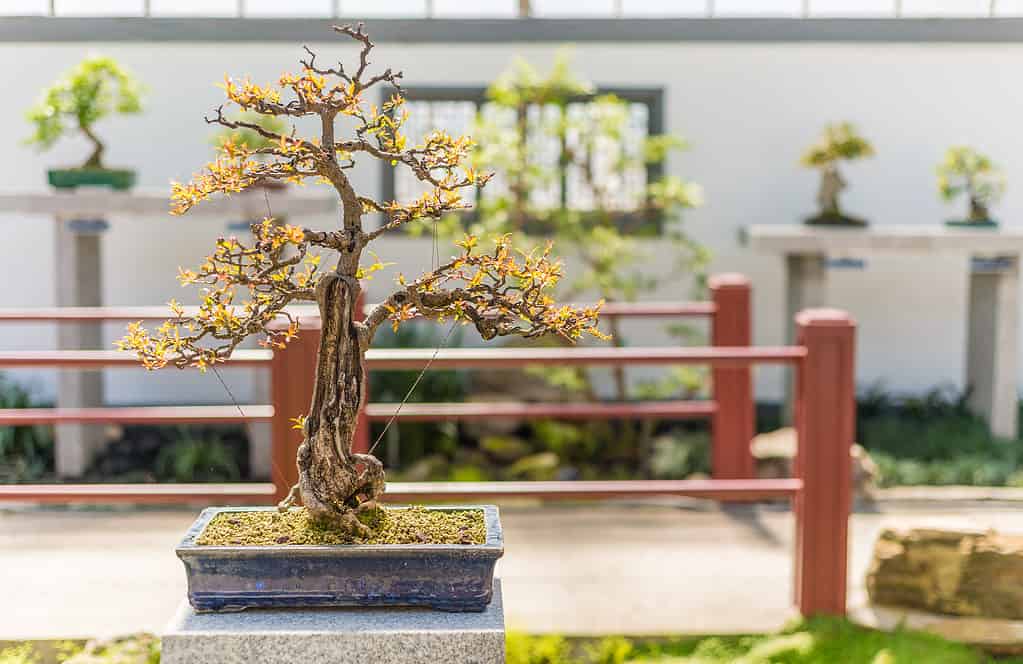
When they are well-cared for, dwarf pomegranate bonsai can live long lifetimes, like this 75-year-old specimen.
©Marc Bruxelle/Shutterstock.com
Because of the size of the pots that bonsai trees live in, they are prone to soaking up the water faster than the average potted plant. Because of this, it’s important to check your dwarf pomegranate bonsai soil every day. These plants are from somewhat arid, hot areas, so they can tolerate a little drier circumstances than some, but still need consistent watering.
Check the soil daily. If the soil is dry, water the bonsai. If it is still moist, check again the next day. When they have open flowers, they will need more water than the rest of the time. And during winter, they need to have their soil kept slightly moist all season long.
Note that dwarf pomegranate bonsai are prone to root rot, which means you may want to get a moisture to help keep the water levels appropriate (i.e., help you avoid over saturating the roots). The plant also benefits from weekly misting on the leaves and trunk, not the flowers or fruit.
Additional tips:
- Water the plant slowly, instead of pouring or dumping in a lot at once. Let the soil slowly absorb as you water. Otherwise, water will spill out everywhere as the plant processes the water and drainage occurs.
- Many bonsai require watering 2 times daily, once in the morning, and once in the evening. You may well find that your dwarf pomegranate needs this. Check the soil consistently each day to establish the patterns each season.
- Avoid watering the leaves via misting or pouring when the sunlight is direct and hot. This could result in the leaves being burned.
- Always use cool water to care for your bonsai.
- Your pomegranate bonsai will probably be fine with two weekly watering times each week, but, again, check the soil and find the patterns before establishing this habit.
- Don’t want your pomegranate at night.
- Water your bonsai at the same time(s) every day.
Feeding
Your dwarf pomegranate bonsai has some specific fertilization needs to keep in mind.
- Use fertilizer designed for fruiting plants. If you intend to eat the fruit, be especially careful to use safe, organic fertilizers.
- Apply solid organic fertilizers every four weeks or opt for liquid fertilizers every week during growing season.
- Use low nitrogen fertilizers with high potassium and phosphorous content to encourage flower and fruit growth.
- Never fertilize a fruiting plant while it is flowering or producing fruit.
- Avoid fertilizing your dwarf pomegranate bonsai for three months after re-potting.
- Solid fertilizers give better control for the plant care but liquid fertilizers are faster acting.
Shaping & Wiring
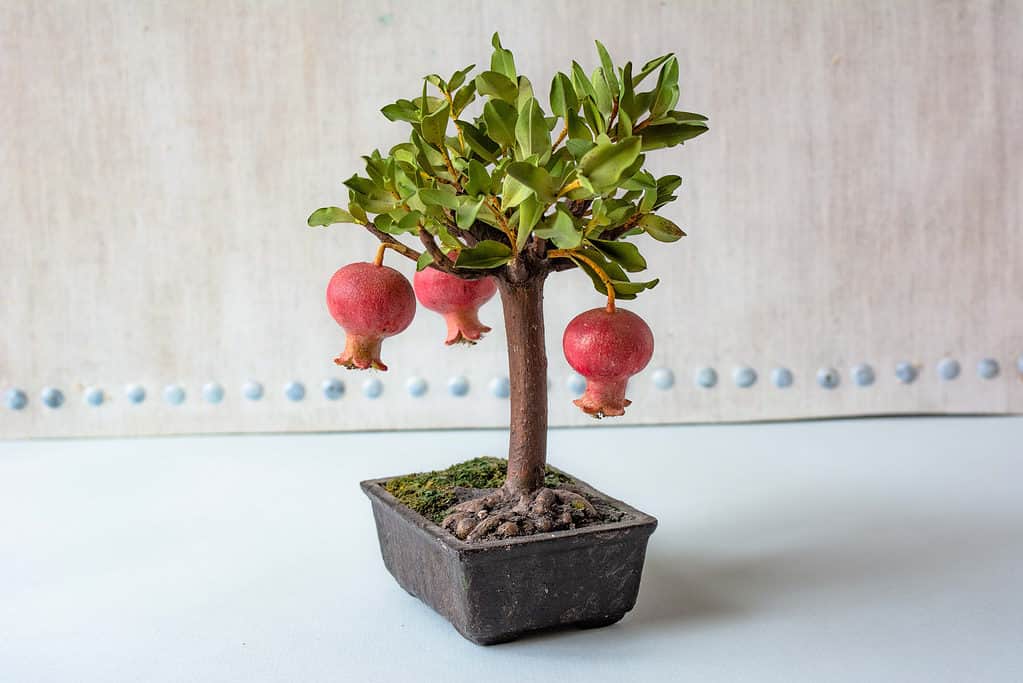
Dwarf pomegranate bonsai may have huge fruit proportionately to the tree, so it’s important not to group them together in one pot.
©Fanni_2021/Shutterstock.com
There are several shaping styles for your pomegranate bonsai that will work well. The top choices tend to be semi-cascade, informal upright, slanting, multi-trunk, and twisted trunk.
The dwarf pomegranate does not do well as a group planting tree, thanks to the fruit, but you can keep several in separate pots for a “forest” effect that will be more versatile for your needs without causing space issues.
You should prune your dwarf pomegranate bonsai during the winter dormancy periods when no leaves are getting in the way. But you will want to trim some of the new shoots when they reach approximately 4 to 6 inches. Don’t prune them before flowering, though, if you want blooms this season. You do need to make sure you trim back enough to prevent too much fruiting to occur, though, as the small tree will be weakened by too many fruits.
You can wire your dwarf pomegranate, too, when there are no leaves on the tree. The older branches are stiff, even brittle, but the newer, younger branches will shape easily.
Re-potting
Dwarf pomegranate bonsai should be re-potted every 2 or 3 years in the early springtime before the leaf buds start to pop open. This tree allows for significant root pruning in the process, which is recommended, as needed, to keep the plant in the appropriate size range for your bonsai pot.
When you re-pot, ensure you’re using the appropriate soil mix (mentioned above) and that it is well-drained, with gravel or similar pieces in the pot to help ensure the drainage happens without blocking the holes.
Remove the old soil from the pot, use a bonsai root rake or similar to loosen and remove the soil from the root ball before trimming the roots. Gently disentangle the roots before trimming and then trim about 15 to 25% of the root mass, as needed, to ensure enough roots remain for a healthy tree while cutting back enough to keep the plant the appropriate size.
Place the roots back into the old pot or the new pot, with all new potting medium, gently lowering it back in. Fill the pot with medium to the brim and work through the soil to remove air pockets. Water the bonsai immediately afterward and place where the plant will get plenty of sunlight and be protected from the wind.
Common Problems of Dwarf Pomegranate Bonsai
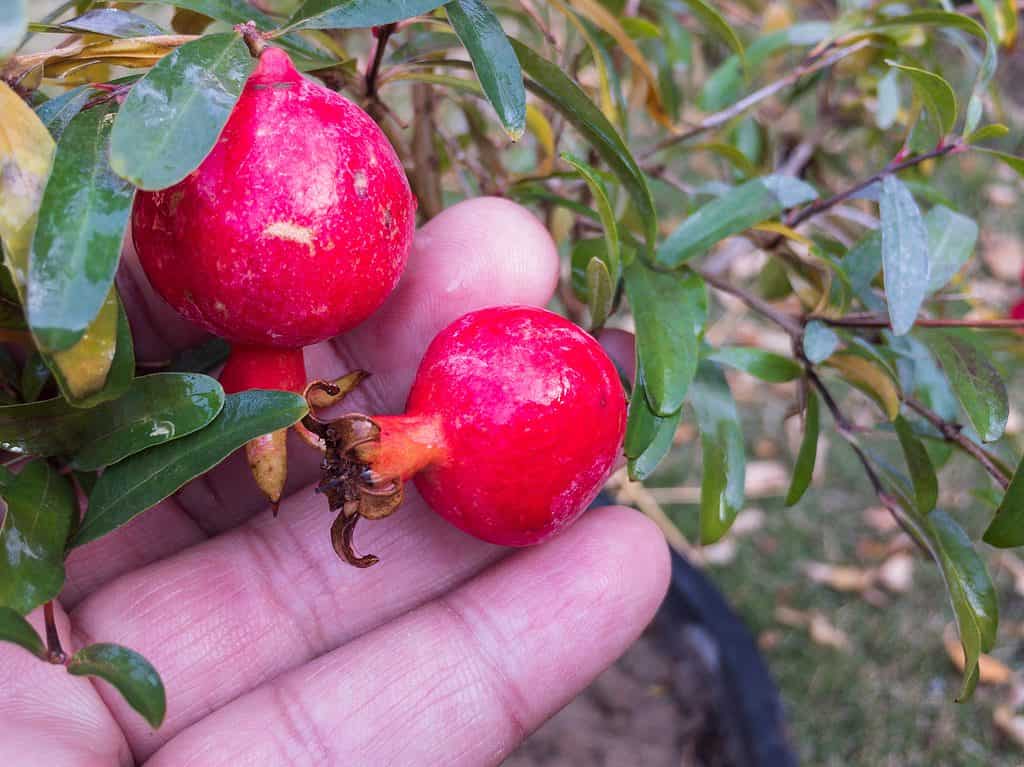
The tiny pomegranate fruit are stunning.
©Bilalstock/Shutterstock.com
One really nice thing about dwarf pomegranate bonsai is that they are rarely attacked by diseases and pests. They can, of course, have infestations, but their higher threshold helps to make them a favorite among enthusiasts.
Pests
Scale, aphids, whitefly, and mealy bugs are the most common invaders of dwarf pomegranates. To deal with these nasty critters, a gentle, nontoxic pesticide is what you’ll need to use. Gentle application and care are required, but generally, this treatment will do the trick.
Root Rot and Mold
Root rot may be the most common non-insect-based issue for dwarf pomegranates. It’s extremely easy to be over-zealous with watering, so a moisture meter is highly recommended to avoid the issue. Check the soil and follow the care carefully to help reduce the likelihood of this issue. If you do find the issue is still occurring, you may need to change up the water you’re using, as well, since calcareous water can cause the issue as well (i.e., tap water). Use distilled or significantly purified water, or rainwater, instead of tap water to help avoid the issue. Also check the drainage on the pot – this may be the actual problem.
How to Propagate Dwarf Pomegranate Bonsai
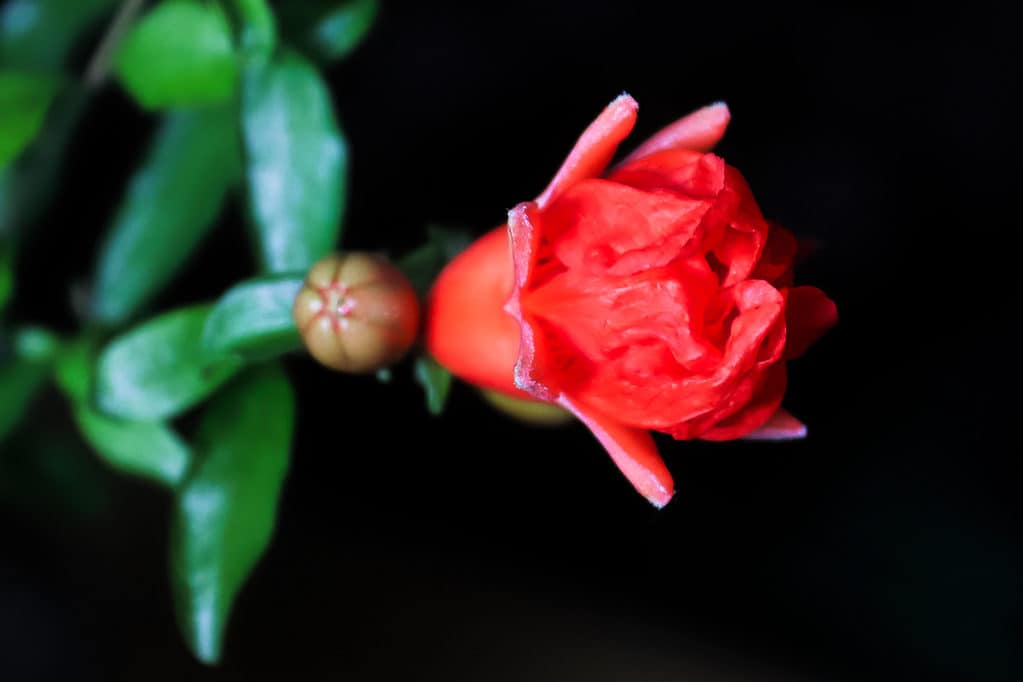
Pomegranate blooms are vividly colored and part of the attraction for the trees as bonsai.
©Amelia Martin/Shutterstock.com
You may propagate a dwarf pomegranate from seed, cutting, or with air layering. The easiest method is going to be cuttings, particularly if you’re interested in a specific plant variety or cultivar. When you grow pomegranates from seeds, they may not look like or bear much similarity to the mother tree. Because of this, we recommend growing your bonsai from cuttings.
- Choose the mother plant from which you’ll take the cuttings. Make sure it’s a healthy plant.
- Take the cuttings in late winter.
- Make sure cuttings are about 10 inches long, with a diameter of at least one-quarter inch.
- Dip the cut ends into growth hormone and insert the powdered cut ends each into their own container of moist growing medium.
- Make sure the top node of the cuttings each stay above the soil to ensure proper growth.
- Water the cuttings immediately and then keep the soil slightly moist until roots develop.
- Once roots develop, move the seedlings each to larger containers (as needed) and treat as young trees.
Dwarf Pomegranate Bonsai Facts and Notes
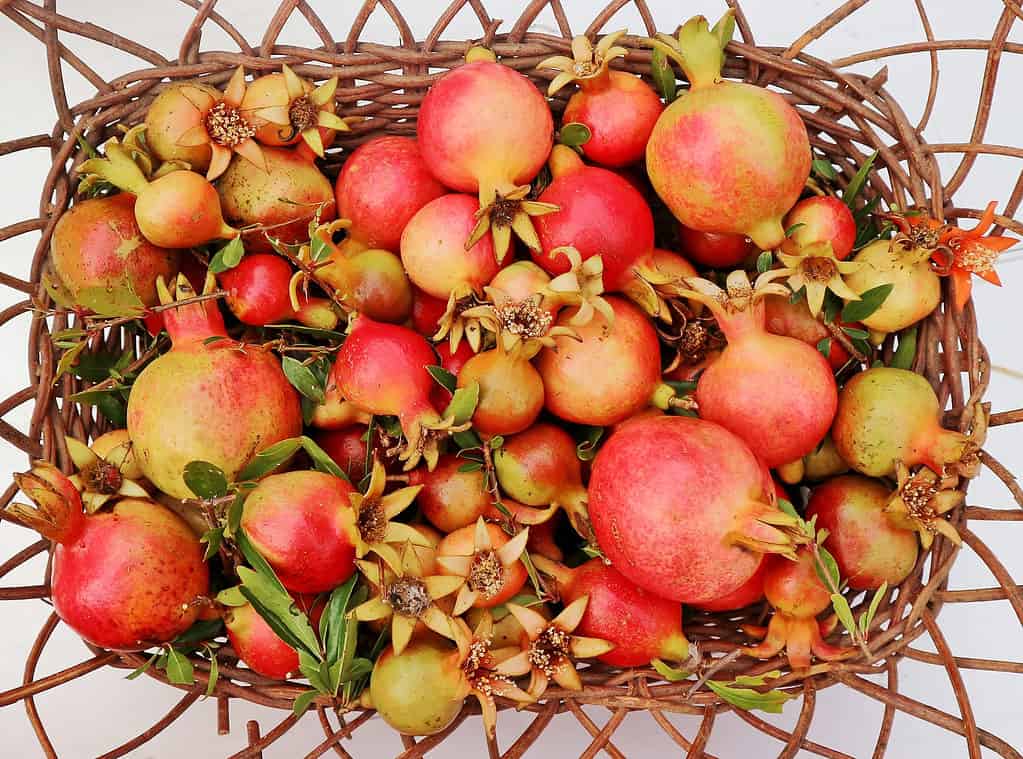
You’ll not likely fill a basket from a single dwarf pomegranate plant, but you’ll certainly enjoy the fruits of your labors when they do produce.
©luca pbl/Shutterstock.com
- Pomegranates have long been used for both flavorful seasoning of foods and for medicinal purposes. They’ve also been actively used in religious practices throughout the Mediterranean region of the world, as well as other nations.
- Pomegranate trees, when properly cared for and kept in the right climate and location, may actually live to up at least 200 years old. We have evidence of this length of life for sure on given trees.
- The ‘Nejikan’ variety of pomegranate naturally grows a twisted trunk, which makes it a popular option for bonsai growers.
- If you buy a growing dwarf pomegranate bonsai tree, make sure you select one that has a thick trunk. This means it is already well-established and won’t take as long for you to grow – and it will be hardier than the thin-trunked options.
Up Next:
- The 11 Best Indoor Bonsai Trees
- 16 Best Flowering Bonsai Trees
- The 10 Best Bonsai Trees for Beginners
- Discover the Oldest Bonsai Tree and Where to See It
The photo featured at the top of this post is © Fanni_2021/Shutterstock.com
Thank you for reading! Have some feedback for us? Contact the AZ Animals editorial team.







